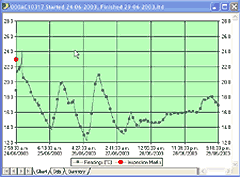Approved Methodology for temperature mapping
Approved Methodology for temperature mapping - Introduction.
This Approved Methodology for temperature mapping is a mandatory requirement whenever regulatory controlled product is being manufactured, and thermal processing or storage is involved (heating or cooling). The individual Operational Qualification (OQ) of the equipment in use, must call for heat distribution; temperature mapping measurement studies of the actual heating or cooling process area used (Cabinet, Room or container). This temperature recording study must verify that all product will be subjected to the same thermal environmental conditions; no matter where the product is situated within the processing area, subjected to temperature mapping. This verification is mandatory and applies to all environmental process and storage equipment such as; mixers, ovens, freezers, hot rooms, cold rooms, sterilizers, warehouses, delivery vans, transport containers, stability chambers, freeze dryers and incubators.
During and after manufacture, the product is often held in storage areas or warehouses, it is essential that the temperature mapping of these storage areas is known to be within the specific requirements for safe storage of the product. It is therefore obvious that all these areas require Approved Methodology for temperature mapping to establish; by way of, documented evidence that the said storage area's are safe for the storage of environmental sensitive product.
The environmental conditions in these facilities are traditionally held to human comfort levels and that is purely within the physical level; humans are comfortable working within. Large fabricated metal storage warehouses can show enormous variations in both heat gains and heat losses. They can in certain locations and certain seasonal times hit highs of plus 60 degrees centigrade and lows of minus 30 degrees centigrade. This renders it essential to ensure your validation performance qualification (PQ) verifies; by way of, extensive temperature mapping, that during these extremes of temperature your product is maintained within the temperature range specified by the product makers.
Heat distribution and temperature mapping studies of large stores and warehouses requires sensors to be fitted strategically throughout the storage shelving, covering a percentage of the shelving area horizontally and vertically. A typical layout for a 1000 Square meter (floor area) warehouse with shelves stacked 4 meters high (giving 4000 cubic meters of storage area); would be one sensor in each corner of the storage area, one midway along each wall and one in the center. This means nine sensors would be placed on the lowest storage shelf, then nine on the middle shelf and finally nine on the top shelf; a total of 27 sensors.
Smaller processing equipment such as; stability chambers, ovens, incubators and autoclaves should be scaled similarly, with one sensor in each corner and one high layer and one lower layer, giving a total in a smaller volume of eight sensors. With an autoclave it is required to place an additional sensor in or close to the drain. Do not insert it down the drain, as it will fail. Remember you are required to demonstrate that climatic condition are uniform throughout the usable product processing areas - down the drain is not such an area.
Temperature Logging Sensors.
Temperature mapping data The use of individual self contained data loggers that measure 1.06" x 3.7" (27mm x 94mm) and have the capacity to log 16,382 temperature points, makes the temperature mapping task much simpler. Logging at one record every 12 minutes gives a time scale of generating records continuously for over 200 days, or 45 hours at one every 10 seconds. The data loggers listed below are used by ourselves for temperature mapping and represent a quantum leap from the troublesome and very expensive, chart recorder days. It is really so simple to place the individual data loggers in place with no power or instrument wiring to obstruct everyday activities in the area. In fact the operators really do not notice that temperature mapping is taking place. At the end of the data logging exercise, the individual loggers are plugged straight into the laptop USB port, and the raw data down loaded. Since this Approved Methodology for temperature mapping is data that is printed out, reviewed and approved as hard copy, 21 CFR Part 11 does not apply.
PLEASE CLICK HERE TO GO TO SHOP
Data Configuration Software.
Data logger configuration software suitable for temperature mapping is supplied, allowing the user to easily set-up the data logger. Selectable parameters include logging rate, measurement units, high & low alarms and start-time. The logged data stored in USB-Data Logger is downloaded via the configuration software. Once downloaded, data can be graphed, printed, or exported to other applications. The data logger configuration software is compatible with Windows 98/2000/XP.
Simple Regulatory Compliance.
The introduction of these self contained data loggers has transformed the task of temperature mapping. No longer do you have to pull fridges, freezers, cold or hot rooms out of service, to carry out temperature mapping of them, no longer do you have to fit expensive chart recorders to obtain process records of temperature mapping, no longer do you have to drill and fabricate bracket for recorders, sensors and power supplies. Just open the door and position a data logger among the load. For Operational Qualification, locate several (depending on volume to be logged) data loggers in the product area along with the product and preferably during routine production. For product records maintain one data logger permanently in the product area. Schedule the data longer for down loading every batch / month / quarter / year. Schedule the data logger for an annual battery change (it will not lose its records due to a flat battery or during battery change). The Approved Methodology for temperature mapping software is equally easy to use and comes free, with the data logger.
News for Today


